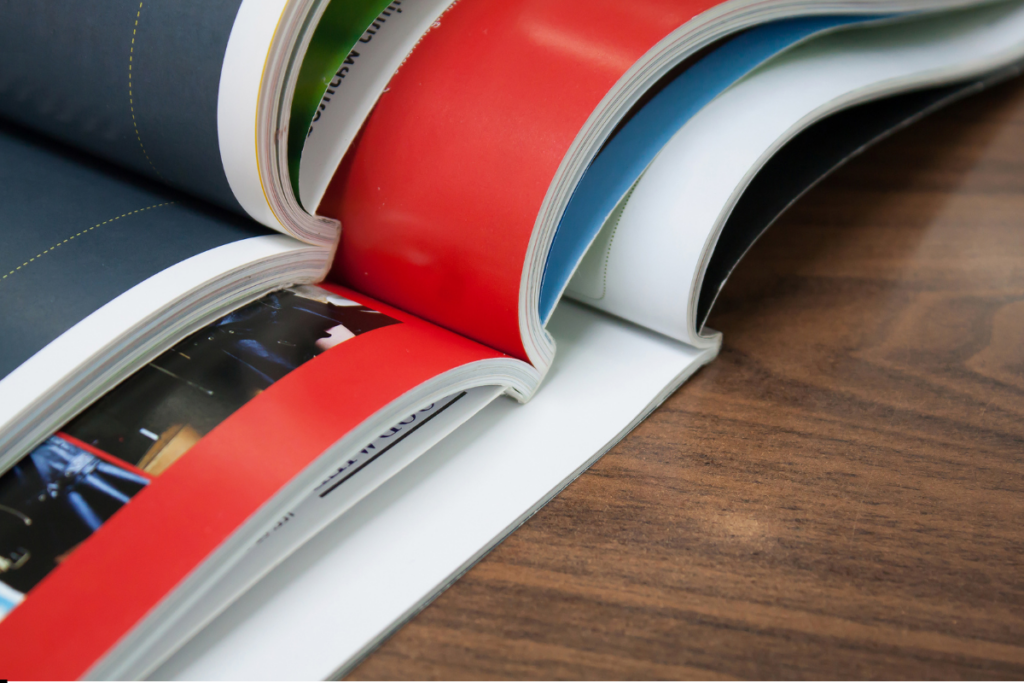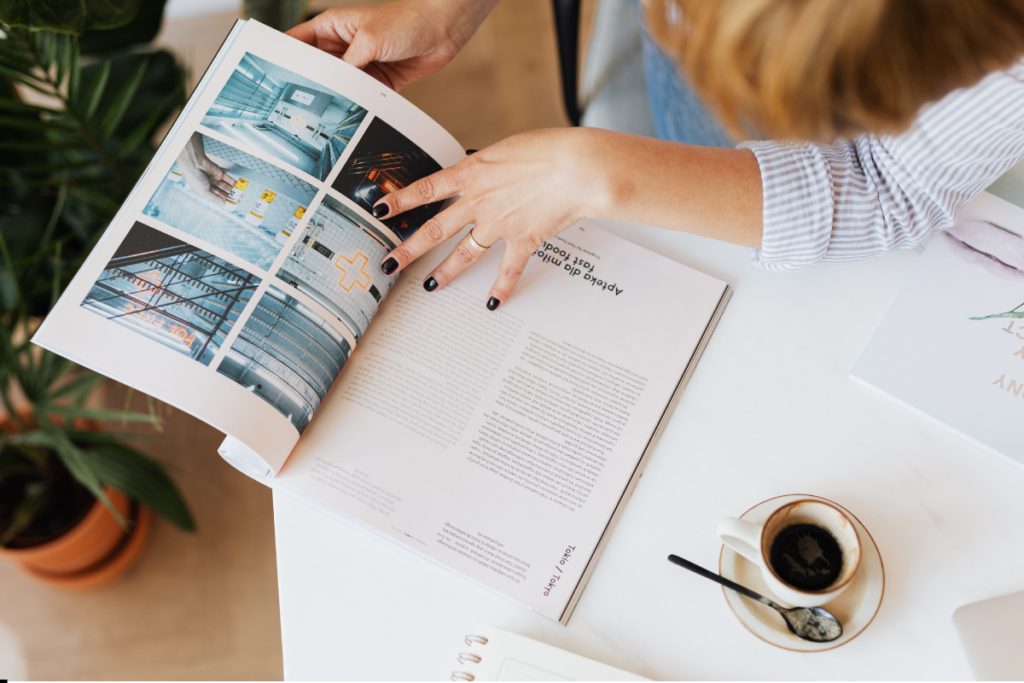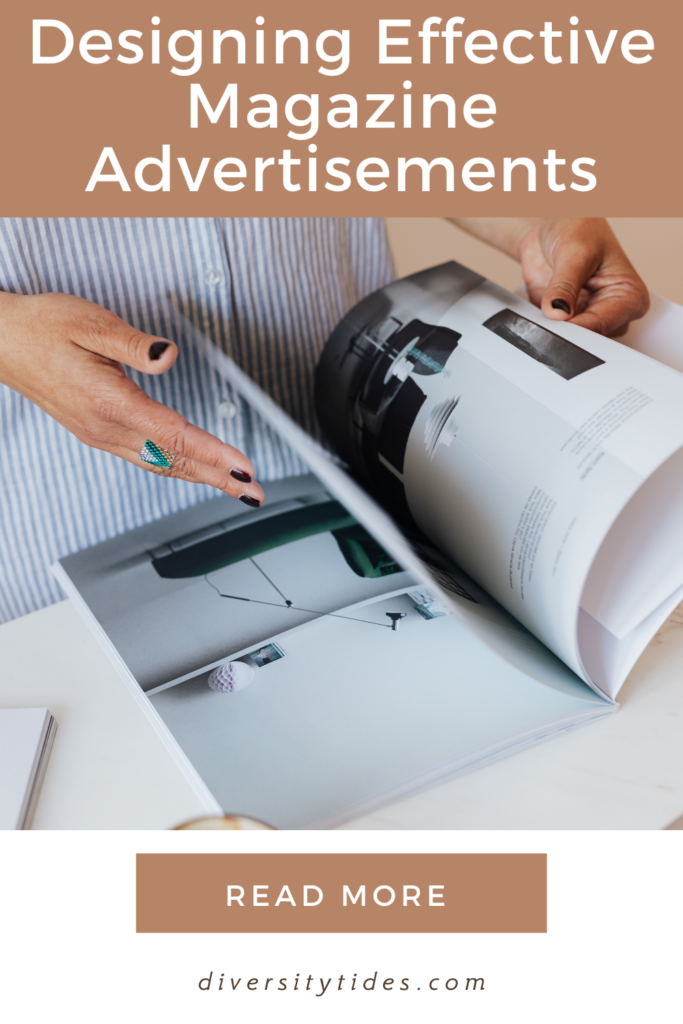In a world dominated by digital content, magazine advertisements remain a powerful medium for brands to communicate their messages and engage their audience.
Despite the rise of online advertising, the tactile nature of print and the curated quality of magazines allow for a unique and immersive experience that can effectively capture readers’ attention.
Crafting effective magazine advertisements requires a blend of creativity, strategy, and understanding of your target market.
This blog post will delve into essential tips and tricks to create impactful magazine advertisements that resonate with readers and drive results.
Understanding the Unique Power of Print Media

Magazine advertisements occupy a unique and revered space in the advertising world, distinct from their digital counterparts.
The tactile nature of magazines offers an experience that digital platforms simply cannot replicate.
Readers tend to spend more time engaging with printed material, turning the pages thoughtfully and often revisiting the content.
Immersive environment
This creates an immersive environment where your advertisement can truly shine.
High-quality visuals and the physical presence of magazines contribute to creating a lasting impression.
The texture of the paper, the richness of the colors, and the quality of the imagery all play a part in making magazine ads memorable.
When people pick up a magazine, they do so with an expectation of curated, high-quality content, and your advertisement can benefit from this context.
This means that the ad is not just seen but is experienced in a way that is both deliberate and impactful.
Enhance the perceived value
Additionally, the editorial credibility of magazines can enhance the perceived value of your advertisement.
Being featured alongside respected editorial content lends your ad a sense of legitimacy and trustworthiness.
Readers often develop a loyalty to their favorite publications, and your advertisement can tap into this established trust, making your brand more appealing.
Demographics of magazine readership
Understanding the demographics of magazine readership is also crucial. Different magazines cater to different audiences, from fashion enthusiasts to business professionals to outdoor adventurers.
Knowing where your target audience spends their time allows you to choose the right publications for your advertisements, maximizing their effectiveness.
For instance, an ad for high-end watches would likely perform better in a luxury lifestyle magazine than in a general-interest publication.
In a world rife with digital distractions, magazines offer a break from screen fatigue. Readers are less likely to be multitasking, meaning they can give your advertisement the undivided attention it deserves.
This focused engagement enhances the likelihood of your message resonating and compelling action. In summary, magazine advertisements provide a unique blend of credibility, engagement, and longevity.
Crafting an Engaging Headline: The First Impression Matters
When it comes to magazine advertisements, your headline is your first opportunity to make a memorable impression.
The gateway
It’s the gateway that draws readers into the content, so it’s crucial to get it right. An effective headline should be attention-grabbing, informative, and a true reflection of your brand’s essence.
To achieve this, start by incorporating powerful verbs and dynamic language that convey excitement and urgency.
For example, instead of a straightforward “Introducing Our New Product,” opt for something more engaging like “Discover the Future of Innovation with Our Latest Release!”
This not only captures attention but also piques curiosity, compelling readers to delve deeper into your ad.
Intriguing questions
Intriguing questions can also be highly effective in magazine advertisements. Posing a question invites readers to pause and think, making them more likely to engage with the content.
For instance, a question like “Ready to Transform Your Skincare Routine?” can create an immediate connection with readers who are looking for solutions.
Common pain points or aspirations
Similarly, addressing common pain points or aspirations in your headline can make it more relatable and appealing. The key is to make sure your headline resonates with the reader’s interests and needs.
Another important aspect to consider is alignment with the magazine’s overall theme and aesthetic. Your headline should feel like a natural fit within the context of the publication.
This not only helps in capturing the reader’s attention but also ensures that your ad stands out without feeling out of place.
Furthermore, brevity is your friend
Magazine advertisements often compete with a plethora of other content, so a concise and impactful headline is more likely to capture and hold attention.
Avoid cluttering your headline with unnecessary words; instead, focus on conveying your message in the most straightforward yet compelling manner possible.
A headline like “Elevate Your Everyday Wardrobe” is succinct, yet powerful, conveying both action and benefit in just a few words.
Incorporating relevant keywords
Incorporating relevant keywords is another strategy that can enhance the effectiveness of your headline.
Keywords related to your product or service not only help in drawing the right audience but also ensure that your message is clear and focused.
For example, if you are advertising a health supplement, keywords like “boost,” “health,” and “well-being” can immediately convey the essence of your offering.
Ultimately, your headline sets the stage for the rest of your magazine advertisement. By making it engaging, relevant, and aligned with your brand’s message, you can create a compelling first impression that encourages readers to explore further and take action.
Selecting the right publication
for your magazine advertisement is a critical decision that can significantly impact your campaign’s success.
With a plethora of publications for magazine advertisements available, it’s crucial to carefully consider the characteristics of each publication to ensure that it aligns with your target audience, brand identity, and advertising goals.
Understand who reads the publication
The first step is to understand who reads the publication. You need to know the demographics, interests, and media habits of the readers.
Then, compare that information to your target market. Look for similarities in age, gender, income, and location.
The more similar the publication’s readers are to your target market, the more likely it is that your ad will be seen and remembered.
The publication’s circulation and readership figures
After that, it is crucial to look at the publication’s circulation and readership figures. This will help you understand how many people the publication reaches and how often.
Both the total number of readers and the frequency of reading are important. A publication with a large number of readers and a high frequency of reading is more likely to be seen and remembered by your target audience.
Editorial style and content of the publication
Additionally, consider the editorial style and content of the publication. Does the tone and content of the publication align with your brand’s image and messaging? Do you share similar values and perspectives?
A good fit between your brand and the publication’s editorial content can enhance the credibility and impact of your advertisement.
Evaluate the publication’s advertising rates
Moreover, it is important to evaluate the publication’s advertising rates and negotiate for the best possible placement and pricing.
Consider factors such as the size and placement of your ad, the frequency of insertions, and any available discounts or special packages.
Striking a balance between cost-effectiveness and visibility is crucial to maximizing your return on investment.
The reputation and credibility
Last but not least, the reputation and credibility of the publication within the industry should be considered.
Aligning with a well-regarded and influential publication can only enhance your brand’s image and credibility. Conversely, association with a publication of dubious repute can have the opposite effect.
By carefully selecting the right publication for your magazine advertisement, you lay the foundation for a successful advertising campaign.
Ensure that the publication aligns with your target audience, offers substantial reach, complements your brand’s image, provides cost-effective opportunities, and enhances your brand’s reputation.
With this strategic approach, you can effectively capture the attention of your target market and achieve your desired advertising objectives.
Visual Appeal: The Role of Design and Imagery

In the realm of magazine advertisements, visual appeal is paramount. The design and imagery you choose are often the first elements that catch a reader’s eye and entice them to explore further.
High-quality visuals
High-quality visuals can elevate your advertisement, making it both striking and memorable. The use of bold, vibrant colors, clear, captivating images, and well-balanced layouts can set your ad apart in a crowded magazine.
When selecting images, it’s essential to choose those that resonate with your target audience and align with your brand’s message.
For instance, if you’re advertising a luxury product, opting for high-resolution, aspirational images that evoke a sense of sophistication and exclusivity can be highly effective.
On the other hand, if your product is more casual or aimed at a younger demographic, lively and relatable images can create a connection with your readers.
Typography
Typography also plays a significant role in the visual appeal of your ad. The fonts you choose should not only be legible but also reflective of your brand’s personality.
A sleek, modern font can convey innovation and sophistication, while a playful, handwritten font might be more suitable for a brand with a fun and approachable image.
The size and placement of your text are equally important; key messages should stand out, drawing the reader’s eye and guiding them through the content smoothly.
Whitespace, or negative space
Whitespace, or negative space, is another critical design element that can enhance the overall look of your magazine advertisements.
By strategically using whitespace, you can create a clean, uncluttered layout that allows the key elements of your ad to stand out.
This not only makes your ad more visually appealing but also improves readability, ensuring that your message is conveyed clearly and effectively.
By thoughtfully combining these visual elements, you can create a compelling and aesthetically pleasing advertisement that captures attention and encourages readers to engage with your brand.
Integrating Branding Elements: Consistency is Key
Branding is the cornerstone of effective magazine advertisements, serving as the thread that ties your ad to your broader brand identity.
When readers flip through a magazine, they should be able to instantly recognize your brand from the visual and textual cues you incorporate.
This means that key branding elements such as your logo, color palette, and font style must be seamlessly integrated into your advertisement.
Using a consistent color palette not only makes your ad visually appealing but also reinforces your brand’s identity.
Brand’s overall aesthetic
Choose colors that align with your brand’s overall aesthetic and use them strategically to draw attention to important elements like your headline or call to action.
Font style
Similarly, your font style should be consistent with your brand’s typography guidelines. Whether your brand uses sleek, modern fonts or more traditional, serif styles, maintaining consistency helps build brand recognition and trust.
Your logo
Place it prominently but thoughtfully, ensuring it complements the overall design without overwhelming other elements.
The logo should serve as a signature, confirming the source of the message and instilling confidence in the reader.
The size and placement of the logo can vary depending on the layout, but it should always be easily identifiable.
The tone of your magazine advertisement
It’s also essential to align the tone of your magazine advertisement with your brand’s voice. If your brand is known for its playful and casual tone, your ad copy should reflect that.
Conversely, if your brand is more formal and professional, maintain that voice in your advertisement.
This alignment in tone helps create a cohesive experience for your audience, reinforcing your brand’s personality and making your message more believable.
Imagery
Imagery plays a significant role in brand consistency as well.
The type of images you use should resonate with your brand’s essence and the audience you’re targeting.
High-quality, aspirational images may work well for luxury brands, while more relatable, everyday images could be more suitable for casual or budget-friendly brands.
Ensure that these visuals are not only high-quality but also consistent with the imagery used across your other marketing channels.
Lastly, don’t overlook the small details.
Elements such as taglines, icons, and even the spacing and alignment within your advertisement should be in harmony with your brand’s overall style.
These subtleties contribute to a polished, professional look that can make a significant difference in how your ad is perceived.
By paying attention to these details, you create a unified and memorable brand experience that resonates with readers.
The Power of Persuasive Copy: Writing Compelling Content
Persuasive copy is the backbone of successful magazine advertisements, turning casual readers into engaged prospects.
It’s more than just a collection of words; it’s a strategic effort to connect with your audience on a deeper level.
The core benefits
o craft compelling content, start by focusing on the core benefits of your product or service. Clearly articulate these benefits in a way that addresses the reader’s needs and desires.
For example, instead of just listing features, explain how these features improve the reader’s life. Phrases like “Experience unparalleled comfort with our ergonomic design” paint a vivid picture that resonates emotionally.
Incorporate storytelling elements
Incorporate storytelling elements to create a narrative that captures attention. Humans are naturally drawn to stories, so weaving a compelling tale around your product can make it more relatable and memorable.
Whether it’s a customer testimonial, a behind-the-scenes look at your product’s development, or a fictional scenario showcasing its benefits, storytelling can turn an ordinary ad into an engaging experience.
The tone of your copy should match your brand’s personality and the magazine’s style. If your brand is playful and youthful, infuse your copy with humor and a casual tone.
Engaging the reader directly
Engaging the reader directly can also make your copy more compelling.
Use questions or statements that prompt the reader to think or imagine themselves using your product. For instance, “Tired of restless nights? Discover the mattress that promises rejuvenating sleep every night.”
This approach not only grabs attention but also creates a personal connection with the reader.
Clarity is crucial
Avoid jargon and overly complex sentences that can confuse or overwhelm the reader. Instead, use straightforward, powerful language that clearly conveys your message.
Active voice and strong verbs can make your copy more dynamic and engaging.
Lastly, a strong call to action (CTA) is essential
Whether you want the reader to visit your website, call a number, or purchase a product, your CTA should be clear, direct, and compelling.
Phrases like “Order now to experience luxury like never before” or “Visit our website for an exclusive discount” provide a clear next step for the reader to follow.
By blending these elements, you can create persuasive copy that not only captures attention but also inspires action, turning readers into loyal customers.
Trends and Innovations in Magazine Advertising
In today’s fast-paced advertising landscape, magazine advertisements are evolving to stay relevant and engaging.
Incorporation of augmented reality (AR)
One of the most exciting trends is the incorporation of augmented reality (AR) features. By using their smartphones, readers can interact with advertisements in a dynamic, multi-dimensional way.
Imagine a beauty ad where scanning the page with your phone brings up a virtual makeup trial or a fashion ad that lets you see a 360-degree view of an outfit.

These interactive experiences not only capture attention but also offer a unique way for consumers to engage with brands.
Sustainability
Sustainability is another significant trend shaping the future of magazine advertisements. As consumers become more environmentally conscious, brands are responding by using eco-friendly materials and printing practices.
Biodegradable inks, recycled paper, and sustainable packaging are becoming standard, allowing brands to communicate their commitment to the planet.
This shift not only appeals to eco-minded readers but also enhances the overall brand image.
Personalization
Personalization is also making waves in the realm of magazine advertising. Advances in data analytics allow brands to create highly targeted ads that speak directly to individual reader preferences.
For example, a travel magazine might feature personalized vacation package ads based on the reader’s previous interests or locations they’ve shown interest in.
This level of customization increases the likelihood of engagement and conversion, making advertisements more effective.
The integration of QR codes
Moreover, the integration of QR codes is making it easier for readers to transition from print to digital seamlessly.
A simple scan can lead them to exclusive online content, special promotions, or direct purchasing options, bridging the gap between offline and online marketing.
This hybrid approach enhances the overall user experience and provides measurable metrics for brands to assess the effectiveness of their print campaigns.
Storytelling being adapted in innovative ways
Lastly, storytelling remains a powerful tool, but it’s being adapted in innovative ways. Brands are using serialized ads, where each issue of a magazine reveals a new part of the story, keeping readers eagerly awaiting the next installment.
This narrative technique builds anticipation and sustained interest, making the ad campaign more memorable.
By staying ahead of these trends and innovations, brands can create magazine advertisements that are not only eye-catching but also deeply resonant with modern readers.


An insightful guide on crafting magazine ads that captivate and convert—essential reading for any marketer!
Yeah, thank you for reading and commenting.